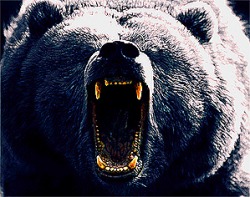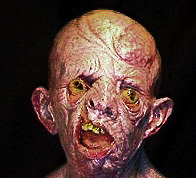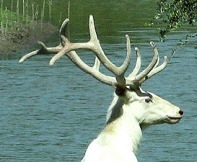Shallock’s Land Guide
Marchbeast

The Whitemarch is a frozen desert known to distort and twist the creatures unfortunate enough to survive its katabatic gales. One animal known to roam the wastes is a breed of monster called the Marchbeast. There are no exact numbers of their kind, but the Atash Bagram estimates, published yearly in Shallock’s Land Guide, put their population at about 80-90 within two hundred miles of the outermost boundaries of the Territory of Loka, according to evidence from junkers and hunters, and the reports of royal border patrols.
The Marchbeast is a descendant of the Svargan bear, its lineage misshapen over the centuries by the vile atmosphere of the wastes into something far more terrible than its ancestors, occasionally reaching up to two tons and fifteen feet in length. Each behemoth is born blind, which through process of sensory elimination provides it with an unparalleled sense of smell and of hearing. Like the Druj, inbreeding and harsh conditions have crafted demented killing machines out of them. As an adult, they wander the earth in a berserker fury, killing and sometimes devouring everything they can catch, stopping to rest only out of exhaustion. There are anecdotes detailing a Marchbeast cub being captured and kept as a ‘pet’ (well, a ‘visitor disposal system’, to be specific) by the bandit lord Aegeon Del for almost fifteen years, but in the wild, because of its violent nature, this creature has a sadly short lifespan of about 5-7 years.
Druj

Not everybody was able to flee underground during the Great War. Some of them were left to contend with the aftermath, and their families have survived to this day. The Druj are the contemporary descendants of those unlucky surface dwellers, hulking, hideous brutes driven to the brink of madness by their painful, twisted shapes and atavistic bloodlust. No Druj is just like another. Viramarga records indicate a wide range of infirmities, such as Druj with three arms, Druj with giant heads, Druj with tails, Druj with no head at all, wolf-like Druj, reptilian Druj, Druj with seven eyes, and Druj with only one enormous arm. Some anecdotes recall a male and a female Druj fused at the spine, and one rare case details an encounter between a junker merchant, his mercenary escort, and a completely insane, gibbering twelve-foot Druj that propelled itself through the treetops like a giant monkey.
No population estimates are available since the Druj tend to wander out of the wastes, drawn to the Oasis Thaw, and are soon killed or die of the nasush, but records indicate that Druj appearances average around once a week. The Viramarga patrolling the border drive away or kill most of them, but once about every month or two one of them gets through and gravitates to a city, usually outlying Pasu-Abhasa municipalities like Adele and Leone. They are classified as ‘wildlife’ only because they are incapable of intelligent civility, or coherent behavior.
Elder Pasu tribesmen contend that the Druj are distant relatives of the Pasu as a whole, precursors to the modern tribes, deteriorated by inbreeding and the harsh life of the wastes into the grotesque, disgusting barbarians they are today.
Goshorun

The Goshorun, a sort of large, grazing ruminant with six legs and a dense skull studded with long-reaching antlers, its entire body draped in ropes of wooly white hair. It is a grazing animal, and is hunted all over the Plains of Bhuma and the Sastra Forest for its pelt and meat. However, as the population of Loka grows, the Goshorun has dwindled until it has become necessary for many homesteaders to raise them in captivity.
General Fauna and Flora
Any common creature and plant can be found across Loka, from the chipmunk to the rose, from ivy to the starling. A diversity of ancient Svargan foliage has widely taken root across the once-blasted country from unknown origins, providing travelers and animals alike with an abundance of food and shelter. Depending on the local climate, the flora and fauna may vary vastly from area to area.


